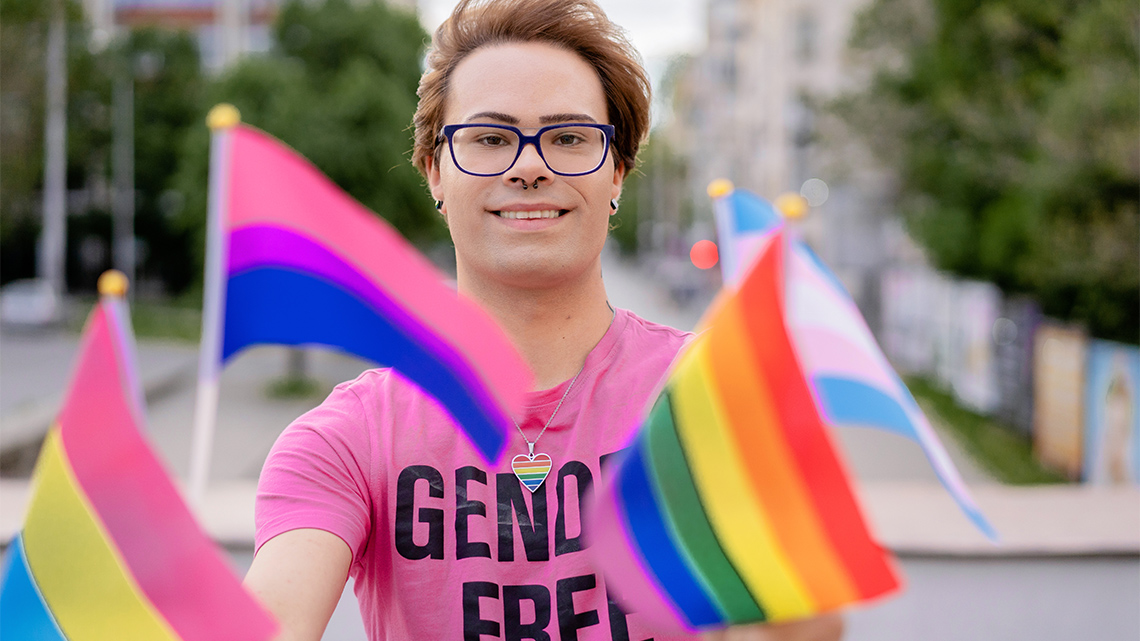Minds On
Stereotypes
A stereotype is an oversimplified image applied to a group of individuals. Some stereotypes may be simple such as “all teachers are organized,” while others can be disrespectful.
Stereotypes allow people, consciously or subconsciously, to make assumptions about an individual because they may be part of an identifiable group based on race, gender, or sexuality.
Gender stereotypes
When dealing with gender stereotypes, these traditional misconceptions can lead to even more potentially hurtful assumptions, in terms of what is viewed as “masculine” or “feminine.”
Pause and Reflect
Reflection
Come up with a list of gender stereotypes that you are aware of or have encountered in your life for “male,” “female,” and “non-binary.”
Examples of gender stereotypes:
- all boys excel at sports
- all girls like to wear makeup
- all non-binary people wear gender-neutral clothing
Press ‘Definition’ to access a definition of non-binary.
Non-binary are gender identities that are not exclusively masculine or feminine.
Reflect on:
- perceptions in the media
- values within your own family
- socializing with friends
Explore
Record your thoughts about the following questions using a method of your choice:
- Which of these stereotypes do you remember recognizing at a young age?
- Which stereotype do you find the most offensive or disrespectful?
- Those who identify as non-binary are often under-represented in the media. Why do you think that is?
- Explore this carousel of images and descriptions. How do these images relate to gender stereotypes?
Gender-based violence, sexual abuse, abusive relationships, and bullying are issues that would affect many members of our community. Society needs to continue to strive in creating safe spaces that are tolerant toward all individuals regardless of their race, gender, or sexuality.
Action
Gender-based violence
In the Minds On section, you explored gender stereotypes as witnessed in the media and real life. Gender stereotyping can lead to gender-based violence.
What is gender-based violence?
Press ‘Definition’ to access a definition for gender-based violence.
Gender-based violence is violence against people who identify as women, girls, transgender, or gender non-conforming. This behaviour is intended to control, humiliate, or harm the individual.
When someone has an inaccurate and inappropriate view of a person based on their gender, their ability to correctly identify gender-based violence will be weakened.
Impacts of violence

Violence of any kind can have short- and long-term impacts on the victims.
Short-term impacts are those that exist for a small amount of time, typically while it is happening and immediately after.
Long-term impacts are those that last for at least one year after the violence.
Some examples of these impacts include:
- psychological impacts, such as sadness or shame
- physical and mental health impacts, such as physical injury, stress, depression, or post-traumatic stress disorder [PTSD]
- social impacts, such as withdrawal from people out of fear for safety, loss of reputation, or loss of income
Bystanders can also experience some of these impacts. The perpetrator may experience legal consequences and psychological impacts, such as guilt or shame.
Examples of gender-based violence

Gender-based violence can affect all people, but it disproportionately affects people who identify as women, girls, transgender, or gender non-conforming, and marginalized communities.
One example is the systemic violence that Indigenous women and girls have experienced in Canada for years.
Press ‘Definition’ to access a definition of systemic violence.
Systemic violence is harmful practices by organizations that should protect specific groups of people. These can harm people psychologically, mentally, culturally, economically, spiritually, or physically.
Other examples include:
- being touched inappropriately in a public or private space
- being held down and touched
- physical assault in a relationship
- sexual assault, including rape
- sex trafficking (someone being controlled by someone else and coerced to perform sex acts for money, food, alcohol, or drugs)
Support for victims of gender-based violence

The first place a person should go if they feel that they have been a victim of gender-based violence is to a trusted adult.
Other facilities that offer support include:
- schools (counsellors, information for organizations that can support)
- shelters
- community centres
- health care professionals
There are also help lines that are available for support. There is information about these help lines in a school, community centres, health care facilities such as clinics.
In many communities, there are after-school youth programs and clubs that help by providing a safe, fun place to socialize.
Some schools and community centres have gay-straight student alliances that also provide safe spaces.
Pause and Reflect
Reflection
Reflect on the following questions and record your answers using a method of your choice:
If someone who has been a victim of gender-based violence reached out for help and shared their story but asked you not to tell anyone, what should you do? Should you tell someone?
Press ‘Answer’ to access a possible response to check your answer.
Possible answer: You could share this information with a trusted adult because the impacts on this victim are concerning and potentially dangerous for them.
Why might they not want to share this information with anyone?
Press ‘Answer’ to access a possible response to check your answer.
Possible answer: They may feel shame or embarrassment.
Consolidation
Public service announcement

Using your preferred method of communication (digital poster, video, or audio), create a message that brings attention to gender-based violence.
Keep your message simple but clear and consider the audience that you are communicating with.
Consider including information about:
- the impacts of gender-based violence on the person being victimized
- some examples of gender-based violence
- how stereotyping can lead to violence
- the supports that are available to someone who has been victimized
In your PSA, be sure to identify possible support services that are available to survivors of gender-based violence.
Reflection
As you read the following descriptions, select the one that best describes your current understanding of the learning in this activity. Press the corresponding button once you have made your choice.
I feel…
Now, expand on your ideas by recording your thoughts using a voice recorder, speech-to-text, or writing tool.
When you review your notes on this learning activity later, reflect on whether you would select a different description based on your further review of the material in this learning activity.



